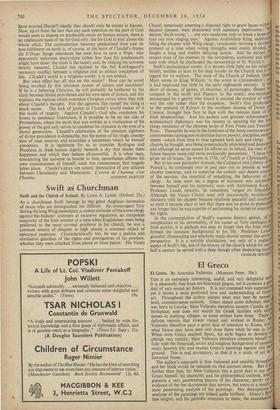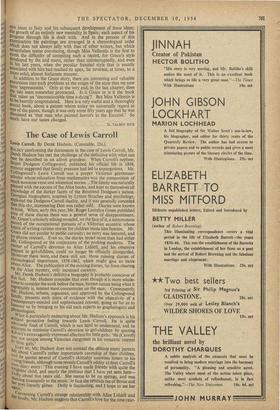El Greco
El Greco. By Antonina Vallentin. (Museum Press. 30s.)
THIS is an extremely interesting, useful, and very delightful bd, It is pleasantly free from art-historical jargon, yet it contains a deal of very sound art history. It is not crammed with superlain, yet it shows a most profound love and understanding of Grec,ni art. Throughout the author adopts what may best be termen,,, level, common-sense outlook. Greco stated quite definitely that,', was born in Candia; Miss Vallentin therefore accepts Candia a ,s birthplace, and does not search for Greek families with sinl names in outlying villages, as some writers have done. There.4 definite records that Greco visited and worked in Rome; Vallentin therefore pays a good deal of attention to Rome, what Greco may have seen and done there while he was in 104, When once Greco reached Spain, his style began to develop change very rapidly; Miss Vallentin therefore concerns herself ve', fully with the historical, social and religious background of cont.cn! orary Spanish life, and studies Greco's paintings against this ba`d ground. This is real art-history, in that jt is a study of art in " historical frame.
The author's approach is thus balanced and sensible throu8114/4 and her book would be valuable on that account alone. But it.,_„g".0 further than that, for Miss Vallentin has a good deal to say an',0 Greco himself, his character, and his philosophical outlook, and presents a very penetrating picture of his character, partly on evidence of the few documents that survive, but more as a result °pi most penetrating analysis of his paintings. Her descriptions 0,,/ analyses of the paintings are indeed quite brilliant. Greco's BY71 tine origins, and his periodic reversion to them; the assimilation II,ew ideas in Italy and his subsequent development of these ideas; the growth of an entirely new mentality in Spain; each aspect of his Progress through life is dealt with. And in the process of this examination his paintings are arranged in a chronological order Which does not always tally with that of other writers, but which nevertheless seems convincing, though Miss Vallentin is the first to stress the difficulty of compiling such a record, for Greco's style developed by fits and starts, rather than uninterruptedly, and even in his last years, when the peculiar frenzied style that is usually associated with him had reached its apex, he reverted, at times, to a more solid, almost Italianate manner. In addition to the Greco story, there are interesting and valuable excursions into such problems as the origin of the style that we now term 'expressionist.' Only at the very end, in the last chapter, does the tale seem somewhat protracted. Is it Greco or is it the book that takes an `unconscionable time a-dying'? But Miss Vallentin is to be heartily congratulated. Here is e very useful and a thoroughly sound book, about a painter whom today we universally regard as one of the giants, though it was only some fifty years ago that he was dismissed as 'that man who painted horrots in the Escorial.' So much have our tastes changed.
D. TALBOT RICE









































 Previous page
Previous page